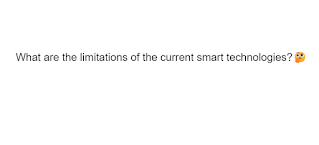What are the limitations of the current smart technologies?
Question: What are the limitations of the current smart technologies?
1. Privacy and Security Concerns: Many smart devices collect and process sensitive personal data, raising concerns about data breaches, unauthorized access, and misuse of information. Ensuring robust privacy and security measures remains a challenge.
2. Interoperability Issues: Different smart devices and platforms often use proprietary technologies and protocols, making it difficult for them to seamlessly communicate and work together. This lack of interoperability can create a fragmented user experience and limit the full potential of interconnected devices.
3. Reliability and Dependability: Smart technologies heavily rely on internet connectivity and cloud-based services. Network outages or server failures can lead to disrupted functionality, affecting the overall user experience.
4. Complexity and User Interface: Some smart devices can be overly complex to set up and use, which may discourage certain users from adopting them. The user interface and interaction design need to be intuitive and user-friendly to appeal to a broader audience.
5. Power Dependency: Smart devices are often battery-powered, and power efficiency remains a challenge. While efforts are made to optimize power usage, some devices may require frequent charging or battery replacements, impacting their convenience and usability.
6. Limited Adoption in Certain Areas: Not all regions or communities have access to high-speed internet, which is essential for many smart technologies to function optimally. Additionally, the cost of smart devices can be a barrier for widespread adoption in certain socioeconomic groups.
7. Ethical and Social Implications: The increasing integration of smart technologies in various aspects of life raises questions about ethical dilemmas and social impact. Issues such as algorithmic bias, job displacement due to automation, and the erosion of privacy in public spaces need careful consideration.
8. Lack of Standardization: The lack of standardized protocols and frameworks for smart technologies can hinder cross-platform compatibility and result in a fragmented ecosystem.
9. Maintenance and Longevity: Smart devices can become outdated relatively quickly due to rapid technological advancements. Ensuring long-term support and maintenance for older devices can be challenging.
10. Environmental Impact: The production, disposal, and energy consumption of smart devices can have adverse effects on the environment, contributing to electronic waste and carbon footprint.
It's worth noting that technology continues to evolve rapidly, and some of these limitations might have been addressed or improved in the time since my last update. Nonetheless, these challenges provide an overview of the areas where smart technologies are still striving to reach their full potential.


0 Komentar
Post a Comment